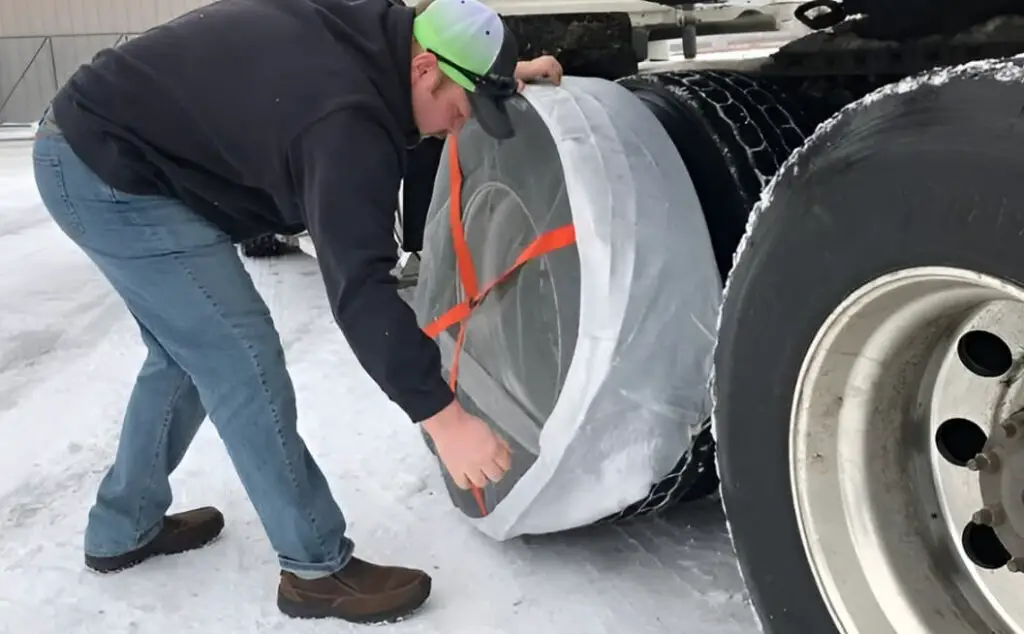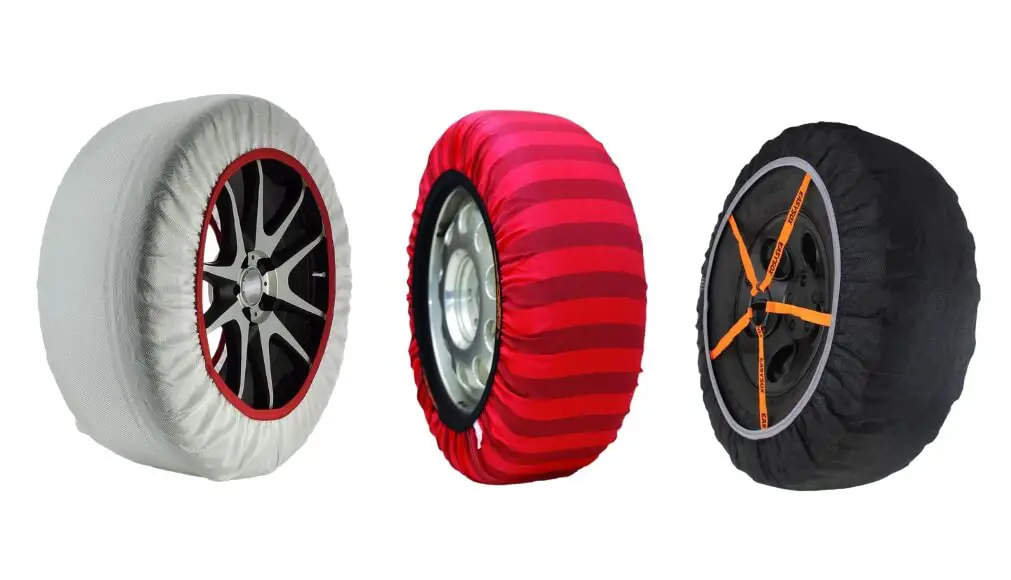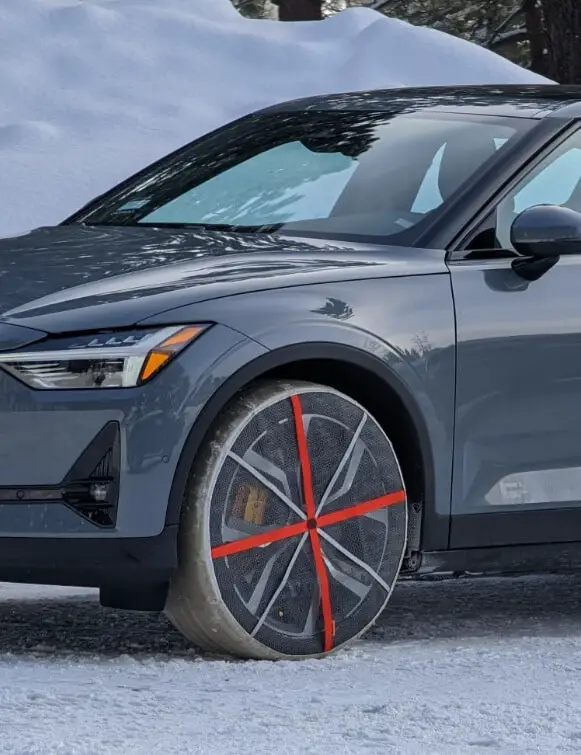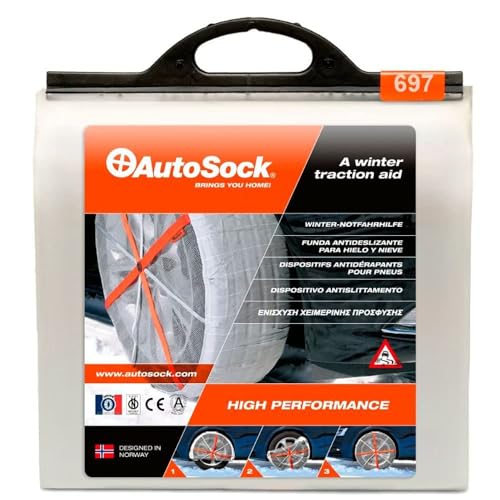Dreading winter roads? Learn how to install tire socks safely and quickly in just a few simple steps. Even if you’re an absolute DIY beginner, this guide has got you covered. With our 5 easy steps, you’ll be ready for those slippery surfaces in no time. Don’t let winter catch you off guard. Dive in now and stay safe!
Navigating the challenges of winter roads requires preparation, and tire socks have emerged as a frontrunner in this battle against slippery terrains. While many drivers still ask, “what are tire socks?”, their efficacy is undoubted. These socks for tires in winter, which are essentially fabric covers, grant improved grip on snowy surfaces.

Now, let’s address a burning question – How to install tire socks for maximum traction?
Installing tire socks for maximum traction involves selecting the right size for your tire, ensuring a clean tire surface, positioning the sock correctly, and then rolling the vehicle to secure the sock in place. Always double-check the fit before driving.
In a Hurry? Here are our top choices and the best snow socks for tires with superior grip:
Last update on 2024-05-19 / Affiliate links / Images from Amazon Product Advertising API
For the uninitiated, this might sound daunting. But, does it have to be? The answer is a resounding no. With succinct instructions and a pinch of patience, installing tire socks quickly and easily becomes second nature. So, if you’re curious about what is a snow tire sock or wondering, do tire socks really work? Dive deep, and master the art of winter road safety.
What are Tire Socks?
If you’ve ever found yourself wondering, “what are snow socks for tires?”, you’re not alone. With winter roads posing challenges for drivers, finding the right traction solution becomes paramount. Tire socks, snow socks, or winter tire socks as they’re often referred to, are the latest innovation designed to meet this challenge head-on.
So, what are tire socks and how do they work?
In essence, tire socks are fabric-based covers that wrap around the vehicle’s tires to provide additional grip on slippery surfaces. Made of high-quality textile, these socks increase the friction between the tire and the road, offering enhanced traction in snowy conditions.
When asking, “how do tire socks work?”, think of them as footwear for your car, providing the extra grip you need, just like a good pair of winter boots.
Now, let’s delve into tire chains vs snow socks. Traditional snow tire chains are made of metal and physically bite into the ice or snow for grip. While they’re effective, they can be cumbersome to install, especially for first-timers installing tire socks on a car.

On the other hand, best snow socks for tires offer a simpler, quicker installation process. When choosing the right tire socks for your vehicle, it’s essential to consider the ease of use, especially if you’re often on the move.
But how do snow socks work when compared to chains? While tire socks offer numerous benefits, such as protecting the road and being gentler on tires, they might not be as durable as chains in extremely rough conditions. Understanding both what are the benefits of using tire socks and what are the drawbacks of using tire socks can help drivers make an informed decision for their winter travel needs.
Must check: The Best Alternatives to Snow Chains for Tires: An In-Depth Guide
Why Use Tire Socks Over Traditional Chains?
The age-old debate, especially in frosty conditions, tends to revolve around traction solutions: are snow socks as good as chains? While traditional chains have been the go-to for many years, tire socks are making a robust case for themselves, especially among modern drivers.
Let’s explore the reasons behind the increasing popularity of tire socks and in which situations they might outshine their metal counterparts.
Benefits of Tire Socks
Tire socks, a breakthrough in winter traction tools, are rapidly becoming the preferred choice over traditional snow chains. What are the benefits of using tire socks over snow chains? Their increasing popularity is due to a host of advantages they present.
- Easy Installation and Removal: One of the primary benefits of using tire socks that are easy to install and remove is the convenience. You can be ready to roll by installing tire socks quickly, without the hassle and time-consuming process of chains.
- Improved Traction: Benefits of using tire socks to improve traction are evident on both snow and ice. While many question, “do tire socks work on ice?”, the answer is a resounding yes, ensuring safe drives even on icy terrains.
- Speed Limits: You might wonder, “how fast can you drive with snow socks?” Their design allows for relatively higher speed limits compared to chains, offering more flexibility.
- Vehicle Safety: Chains, if improperly fitted, can damage a vehicle’s wheel wells or suspension. Conversely, effortlessly installing tire socks for winter safety ensures no harm comes to your vehicle.
- Lightweight and Portable: Tire socks are lighter than chains, making them easy to store and transport. This lightweight nature also means less strain on your vehicle.
- Compatibility with Vehicle Systems: Tire socks don’t interfere with a vehicle’s electronic stabilization programs. In the debate of “are tire socks better than chains?”, this compatibility gives tire socks an edge.
Situations Where Tire Socks are More Advantageous:
For those frequently swapping between different vehicles, learning how to install tire socks on a truck can be just as straightforward as on a sedan, making it versatile. The DIY tire sock installation guide makes the process accessible, even for beginners. Here are the situations and driving scenarios where tire socks are more advantageous:
- Emergency Use: Snow socks are quick and easy to install, perfect for unexpected snowfall.
- Urban Commuters: Winter tire socks are effective for lighter snow conditions typically found in cities.
- Budget-Conscious Drivers: Often viewed as the best budget snow socks for cars, SUVs, and Pickup trucks.
- Lightweight Requirements: Easy to store and handle, especially for those with physical limitations.
- All Vehicle Types: Versatile sizing for fabric snow chains for truck, SUV, passenger cars.
Moreover, what are the benefits of using tire socks on a car or truck? They are less damaging to road surfaces, reduce vibrations, and offer a quieter ride compared to chains. So, when pondering are snow socks better than chains, remember, it often depends on the specific needs and preferences of the driver.
Must check: Top 5 Textile Snow Chains for Safe Winter Driving
Preparing Your Vehicle for Snow Socks Installation
Before embarking on the journey of how to install tire socks like a pro, it’s crucial to prepare your vehicle adequately. Just as a chef preps their ingredients for the perfect dish, the right groundwork ensures a smooth and efficient tire sock installation. Here’s how you can gear up for the process:
Checking Tire Size and Compatibility
Don’t just assume one size fits all. Consulting a tire socks size chart is paramount to choosing the right tire socks for your vehicle. Whether you’re looking at socks for car tires or truck tire socks, the correct size ensures optimal performance.
Remember, tire socks for trucks might differ from those for smaller vehicles. Always verify to get the best tire snow socks for your specific wheel size.
Cleaning and Inspecting the Tires
Before you delve into the tire sock installation tips and tricks, it’s imperative to start with cleaning and inspecting the tires. Remove any debris, mud, or stones that could hinder the sock’s fit or cause damage. An immaculate tire surface ensures a snug fit and minimizes the risk of slippage.
Positioning Your Vehicle Correctly
A flat, stable surface is key. Ensure your car or truck is in a position that allows easy access to all tires. This may seem like a simple step, but it’s crucial for a seamless installation process, especially if you’re installing tire socks without gloves.
It’s about making the task of how to apply tire socks as hassle-free as possible. Positioning your vehicle correctly not only provides ample space to work but also ensures your safety during the process.
Must check: 13 Best Snow Socks for Tires to Maximize Traction in Winter
How to Install Tire Socks Like a Pro in 5 Easy Steps
Stepping into winter with assurance means equipping your vehicle with the right traction aids. Whether you’re choosing the right tire socks for your vehicle or figuring out how to install tire socks on an SUV or pickup truck, following a straightforward guide ensures you’re prepared for snowy adventures. Here’s the steps of our easy-to-follow tire sock installation instructions:
Step 1: Unpack and Inspect the Socks
Begin by unpacking your tire socks and checking for any visible damages or defects. Just like when purchasing any new product, ensuring its quality is essential.
Carefully spread out the socks and inspect for any tears, frayed edges, or compromised sections. Especially when considering tire socks for trucks, which face greater demands, the durability and integrity of each sock are paramount.
Last update on 2024-05-19 / Affiliate links / Images from Amazon Product Advertising API
Remember, successful journeys begin with meticulous preparations. By inspecting your tire socks, you’re not only ensuring their functionality but also taking the first step in installing tire socks like a pro. This preliminary step sets the foundation for a smooth and efficient installation process.
Step 2: Position the Socks Around the Tire
With your socks laid out, drape them over the top of the tire, ensuring even placement. This might sound simple, but correct positioning is the backbone of installing tire socks effectively. Ensure the front part of the sock aligns well with the tire’s top edge.
The proper alignment ensures that the rest of the tire sock installation flows without hitches. If you’re wondering how to put on snow socks without hassle, spreading the material evenly around the tire’s circumference is the trick.
This step, as outlined in our DIY tire sock installation guide, ensures that the sock fits snugly, enhancing its efficiency on icy or snowy roads.
Step 3: Roll the Vehicle Forward or Backward
Once the socks are in position, slowly roll the vehicle to expose the underside of the tire. This move, essential for how to use tire socks optimally, allows you to complete the sock’s placement around the entire wheel.
Gently rolling the vehicle ensures that you’re covering every inch of the tire’s surface without missing any spots. Think of it as wrapping a gift, where you want every part of the item concealed neatly.
Following this strategy not only makes the process smoother but is a crucial component of how to install tire socks effortlessly. It bridges the gap between a novice’s attempt and a pro’s finesse, ensuring safety and efficacy as you navigate winter terrains.
Step 4: Secure the Socks
With the entire tire accessible, pull the sock’s elastic band around the circumference, ensuring a snug fit. It’s this critical step in tire socks installation that ensures the sock stays in place during your travels.
Regardless of whether you’re installing snow socks for a compact sedan or truck tire socks for heavier vehicles, a tight and even fit is imperative. This isn’t just about aesthetics but about safety and efficiency.
Remember, when you ponder how to install snow socks for tires, think of it as clothing for your vehicle’s feet. Just as you wouldn’t want ill-fitting shoes, neither would your car want loosely fitting tire socks for snow.
Step 5: Double Check Your Work
Safety is paramount; always double-check your installation by inspecting the fit and taking a short test drive. After installing snow socks, it’s easy to assume the job’s done. However, as highlighted in our guide on how to install tire socks in 5 easy steps, verification is crucial.
Take a walk around your vehicle, ensuring each sock sits flush against the tire, without any bulges or gaps. Feel the snugness with your hands. Finally, consider a brief test drive around your block or driveway. It helps in confirming the socks’ grip and will also give you a feel of driving with them on.
Remember, learning how to put on tire socks is only half the journey; ensuring they’re perfectly installed is the clincher to your winter driving preparation.
For an enhanced understanding of the effortless installation of tire socks, check out the video below by Bison Transport. They delve into a comparison, questioning, “Are tire socks better than chains?”. This AutoSock Review will certainly aid in installing tire socks with ease and making an informed decision.
Must check: Top 7 Reasons to Choose K&K Automotive Snow Socks for Your Vehicle
Essential Tips for First-Time Users
Embarking on your maiden voyage with tire socks? This isn’t just about installing tire socks the right way, but also ensuring longevity and safety. Let’s dive into some essential tire sock installation tips and tricks for beginners.
Ensuring a Snug Fit
Taking a comprehensive look at how to install tire socks on a car or truck, the fit is fundamental. Loose socks can be a safety hazard, while overly tight ones can wear out faster. To ensure the perfect fit, always use the manufacturer’s sizing chart, referencing it against your tire’s specifications.
When you apply tire socks, stretch them over the tire, ensuring an even distribution without folds or bulges. Your vehicle’s stability on snowy roads rests on this – it’s the very essence of how to fit tire socks securely.
Driving Slowly after Installation
Once installed, resist the urge to zoom off. Pondering how fast can you drive with snow socks? Especially after the first installation, drive slowly. This ensures the socks settle correctly on the tire and allows you to get a feel of their grip.
As a general tire sock safety tip, maintaining a moderate speed even in well-acclimatized conditions ensures both safety and the longevity of the socks.
Regularly Checking the Socks for Wear and Tear
Your journey into maintaining tire socks begins right after installation. Regular inspections can help in troubleshooting common tire sock problems before they escalate. Check for holes, thinning areas, or any other visible damage.
Remember, it’s not just about ensuring better grip but also about safety. In the realm of crucial tips on how to install tire socks for better grip, this stands as a cornerstone: always ensure your socks are in top condition before embarking on snowy drives.
How Fast Can You Drive with Snow Socks?
When confronting winter’s treacherous roads, many motorists question, “how fast can you drive with tire socks in the snow?” The answer, while slightly variable, revolves around safety. Snow socks, innovative traction enhancers for icy and snowy terrains, come with specific speed guidelines.
The recommended speed to drive with snow socks is typically between 20 mph (30 km/h) and 30 mph (50 km/h). This range is based on various factors including the brand, size, and vehicle type. Exceeding the maximum speed to drive with snow socks can be perilous, potentially leading to loss of vehicle control, particularly in adverse road conditions.
When we talk about the safe speed to drive with snow socks, it’s not just about adhering to the limit but understanding the rationale behind it. Snow socks are specifically crafted for driving with snow socks on a car during challenging winter conditions. They aren’t a direct replacement for snow tires but are excellent in pinch situations.

Knowing the speed limits for snow socks and heeding tips for driving with tire socks on snowy roads ensures you’re not just compliant but safe. Remember, while driving, it’s always paramount to prioritize safety over speed.
Must check: Michelin Easy Grip vs AutoSock Snow Socks: Which Offers Better Snow Traction?
FAQs on How to Install Tire Socks Without Hassle:
For those wanting to master how to install tire socks the easy way, we’ve collated some commonly asked questions. These touch on the nuances of installation, usage, and maintenance to guide you in mastering the art of installing tire socks for maximum traction.
-
When should I use tire socks instead of chains?
Tire socks offer a smoother ride than chains and are easier and quicker to install. For conditions where the snow is not exceedingly thick, and the terrain isn’t too rugged, tire socks might be your best bet. They are particularly useful for vehicles that may not have enough clearance for chains.
-
How do I clean and maintain my tire socks?
Post usage, shake them out to remove any loose snow or debris. Hand washing them in cold water without bleach and letting them air dry will keep them in prime condition. Regularly inspect for any wear and tear to ensure safety.
-
Can I use tire socks on all types of vehicles?
Absolutely. While it’s crucial to reference the manufacturer’s tire sock installation instructions, socks are available for various vehicle types, from cars to SUVs and even larger trucks. However, ensure you choose the right size for optimal fit and traction.
-
Are tire socks legal in California?
Yes, in California, tire socks are considered an alternative to traditional snow chains. However, always check local regulations before traveling as chain control checkpoints might require specific traction devices during heavy snow.
-
How long do tire socks last?
The durability depends on usage and road conditions. With proper care and usage primarily on snow-covered roads, they can last a whole winter season or longer. It’s essential, however, to avoid driving on bare asphalt as it wears them out faster.
-
What’s the fastest way to put on tire socks?
For a quick tire sock installation, lay the sock in front of the tire, drive onto it, and then pull the sock up and over the tire. Using this technique and following easy steps on how to install tire socks for winter roads can cut down the installation time significantly. Remember, practicing a few times can make the process even swifter!
Wrapping Up: How to Install Tire Socks Effortlessly Every Time
As winter’s icy grip tightens, many drivers are looking to fortify their vehicles against slick terrains. This brings us to the rising star in road safety – the tire socks installation.
And if you’re pondering, “what are tire socks and how do they work?”, they’re essentially fabric coverings devised to grant enhanced traction on frosty paths. The installation might sound intimidating, especially for novices. However, with our curated tire sock installation instructions for beginners, that won’t be a problem.
To install tire socks like a pro, first choose the suitable size, lay them over the tire ensuring even placement, roll the vehicle slightly to secure the socks, pull the elastic band around for a snug fit, and then take a test drive to ensure optimum fit.
Venturing into the realm of DIY tire socks? Fear not! By choosing the right tire socks for your vehicle, maintaining them diligently, and having this guide at your disposal, you’ll drive safely, come snow or sleet.
Don’t miss out on these related topics:
- Are Snow Chains Better Than Snow Tires for Winter Traction?
- How Do Automatic Tire Chains Work? A Comprehensive Guide
- Are Studded Tires Better than Chains? An In-Depth Analysis
- Do AWD Cars Need Chains on All Tires? An Expert’s Perspective
- 13 Best Snow Tires for Trucks to Ensure Your Safety in Snowy Conditions



